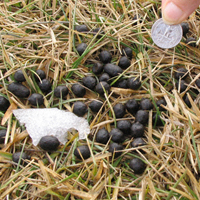Identification | Biology | Damage ID | Management | Handling

The volume of literature on the ecology and management of deer exceeds that for any other species of wildlife. We recommend Biology and Management of White-tailed Deer by Hewitt (2011) as the best single reference. This module contains a brief summary of the biology and methods for the management of deer, using white-tailed deer (Odocoileus virginianus) as an example. Mule deer (O. hemionus) require similar control in all respects. White-tailed deer are found throughout much of North America. Mule deer primarily are a western species found in buttes, draws, and stream bottoms with sufficient forage. Black-tailed deer (O. columbianus) is a subspecies of mule deer.
Legal Status
Deer are protected year-round in all states, with the exception of legal harvest during appropriate hunting seasons. Where severe or persistent damage occurs, states may issue depredation permits to shoot deer at times other than legal hunting seasons. Regulations vary on the necessary permits and on disposal of dead animals. The popularity of deer as game animals and the need to curb poaching have led to the development of severe penalties for illegal possession. Generally, lethal control of deer cannot be initiated before consulting the state wildlife agency. Some states provide technical assistance or compensation for damage by deer.
Physical Description
Deer are even-toed ungulates in the Cervidae family. At birth, fawns are rust-colored with white spots. The spotted coats are shed in 3 to 4 months and are replaced by a grayish-brown winter coat. The summer coat of adult deer is reddish-brown. The area under the tail, the belly, chin, and the throat are always white. The rump, tail, antlers, and ears differ slightly among species




Image by PCWD.
Antlers grow on males (bucks) from April to August. Development of antlers is nourished by a layer of soft, vascularized “velvet.” The dried velvet is rubbed off and the antlers polished during the fall breeding season (rut). Size of antlers depends on nutrition, age, and genetics. The antler tines of male white-tailed deer grow from a central beam, while the tines of antlers of mule deer are forked. In both species, the antlers are deciduous and shed in mid- to late winter.
Size of adults varies with latitude. In northern states, a mature buck may weigh 200 to 300 pounds. Key deer (a subspecies of white-tailed deer) bucks in Florida weigh about 50 pounds. Does typically weigh 25% to 40% less than bucks for all species.
Species Range
White-tailed deer are found in almost every state in the US, except Alaska and Hawaii. They occur throughout the southern provinces of Canada and into Central and South America. Mule deer are common throughout western Canada, the western US, and into Mexico. Several subspecies have been identified for both species.


Voices and Sounds
Deer may emit a warning snort and bleat when in distress.
Tracks and Signs
Deer can be recognized easily by their tracks, trails, and abundant droppings. A single white-tailed deer can deposit 25 pellet groups per day.


Acknowledgements
Information on this species is based on the chapter in Prevention and Control of Wildlife Damage (Hygnstrom, Larson, Timm, ed. 1994), written by Scott R. Craven (University of Wisconsin-Madison) and Scott E. Hygnstrom (University of Nebraska-Lincoln).